Business Proposal: Sippy Recyclable Plastic (Cold Beverage Cup Lid)
VerifiedAdded on 2023/01/12
|18
|5434
|25
AI Summary
The business proposal is to develop and produce biodegradable disposable plastic cold drink cups to replace straws. The concept aims to reduce overall plastic waste and protect the environment. The project aligns with the environmental and regulatory policies of the New Zealand government.
Contribute Materials
Your contribution can guide someone’s learning journey. Share your
documents today.
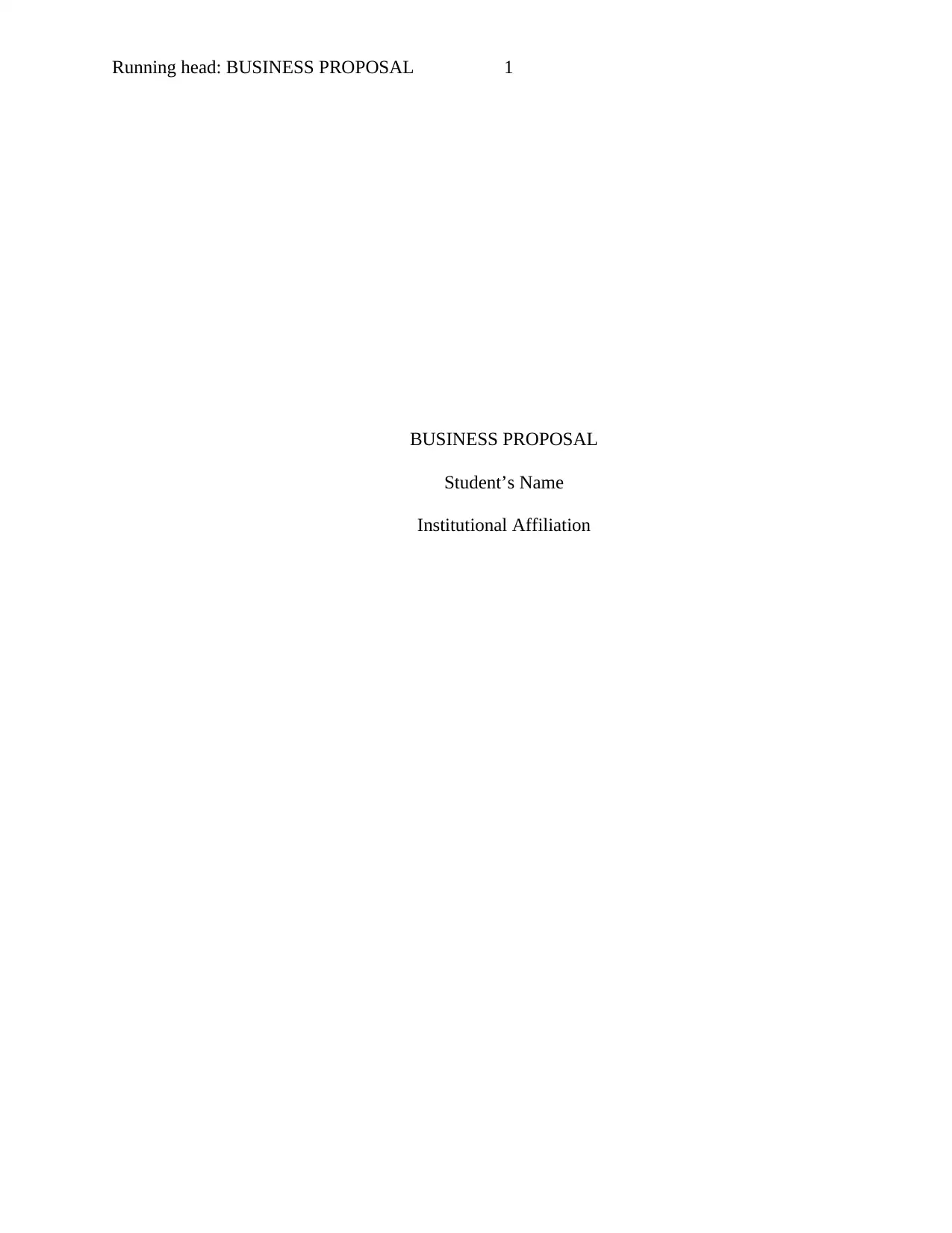
Running head: BUSINESS PROPOSAL 1
BUSINESS PROPOSAL
Student’s Name
Institutional Affiliation
BUSINESS PROPOSAL
Student’s Name
Institutional Affiliation
Secure Best Marks with AI Grader
Need help grading? Try our AI Grader for instant feedback on your assignments.

BUSINESS PROPOSAL 2
BUSINESS PROPOSAL: SIPPY RECYCLABLE PLASTIC (COLD BEVERAGE CUP
LID
Introduction
The business proposal is to develop and produce biodegradable disposable plastic cold
drink cups. The idea is to create and sell the biodegradable plastic so that they replace straws.
The concept and plan were inspired after a trip to Osaka, Japan. During the visit,
Starbucks had introduced a new limited edition of drink in Japan. The bottle was labelled Foam
Latte. The design of the takeaway cup contained a unique lead. The lid of the cold drink is
circular with straw and is made of plastic for ease when drinking (Asghari, Samiei, Adibkia,
Akbarzadeh, & Davaran, 2017). The cup is designed like a baby's Sippy cup. The opening is
enlarged in a way that someone drinking takes the foam and sips the drink at the same time.
When drinking the coffee using a straw, they can only drink the coffee at the bottom, which is
quite a disadvantage. The idea is a total breakdown of the traditional coffee drink cup. If our
company, the Super Lover, could think about designing a cold drink it would be a good chance
of environmental protection. The concept helps reduce overall plastic straws in New Zealand as a
way of protecting the environment. The idea is also a way of environmental protection through
the reduction of plastic straws and introduction of non-biodegradable plastics (Laycock et al.,
2017)
Background of the Concept
Plastics are everywhere at the moment. The environmental rot extends from the far North
Pole to the entire earth (Foote, Joy, & Death, 2015). The use of plastic has brought the planet to
the edge of suffocation. A better part of the suffocation can be attributed to plastic products, one
of them being straw. Statistics have shown that about 830 million plastic straws are produced
BUSINESS PROPOSAL: SIPPY RECYCLABLE PLASTIC (COLD BEVERAGE CUP
LID
Introduction
The business proposal is to develop and produce biodegradable disposable plastic cold
drink cups. The idea is to create and sell the biodegradable plastic so that they replace straws.
The concept and plan were inspired after a trip to Osaka, Japan. During the visit,
Starbucks had introduced a new limited edition of drink in Japan. The bottle was labelled Foam
Latte. The design of the takeaway cup contained a unique lead. The lid of the cold drink is
circular with straw and is made of plastic for ease when drinking (Asghari, Samiei, Adibkia,
Akbarzadeh, & Davaran, 2017). The cup is designed like a baby's Sippy cup. The opening is
enlarged in a way that someone drinking takes the foam and sips the drink at the same time.
When drinking the coffee using a straw, they can only drink the coffee at the bottom, which is
quite a disadvantage. The idea is a total breakdown of the traditional coffee drink cup. If our
company, the Super Lover, could think about designing a cold drink it would be a good chance
of environmental protection. The concept helps reduce overall plastic straws in New Zealand as a
way of protecting the environment. The idea is also a way of environmental protection through
the reduction of plastic straws and introduction of non-biodegradable plastics (Laycock et al.,
2017)
Background of the Concept
Plastics are everywhere at the moment. The environmental rot extends from the far North
Pole to the entire earth (Foote, Joy, & Death, 2015). The use of plastic has brought the planet to
the edge of suffocation. A better part of the suffocation can be attributed to plastic products, one
of them being straw. Statistics have shown that about 830 million plastic straws are produced
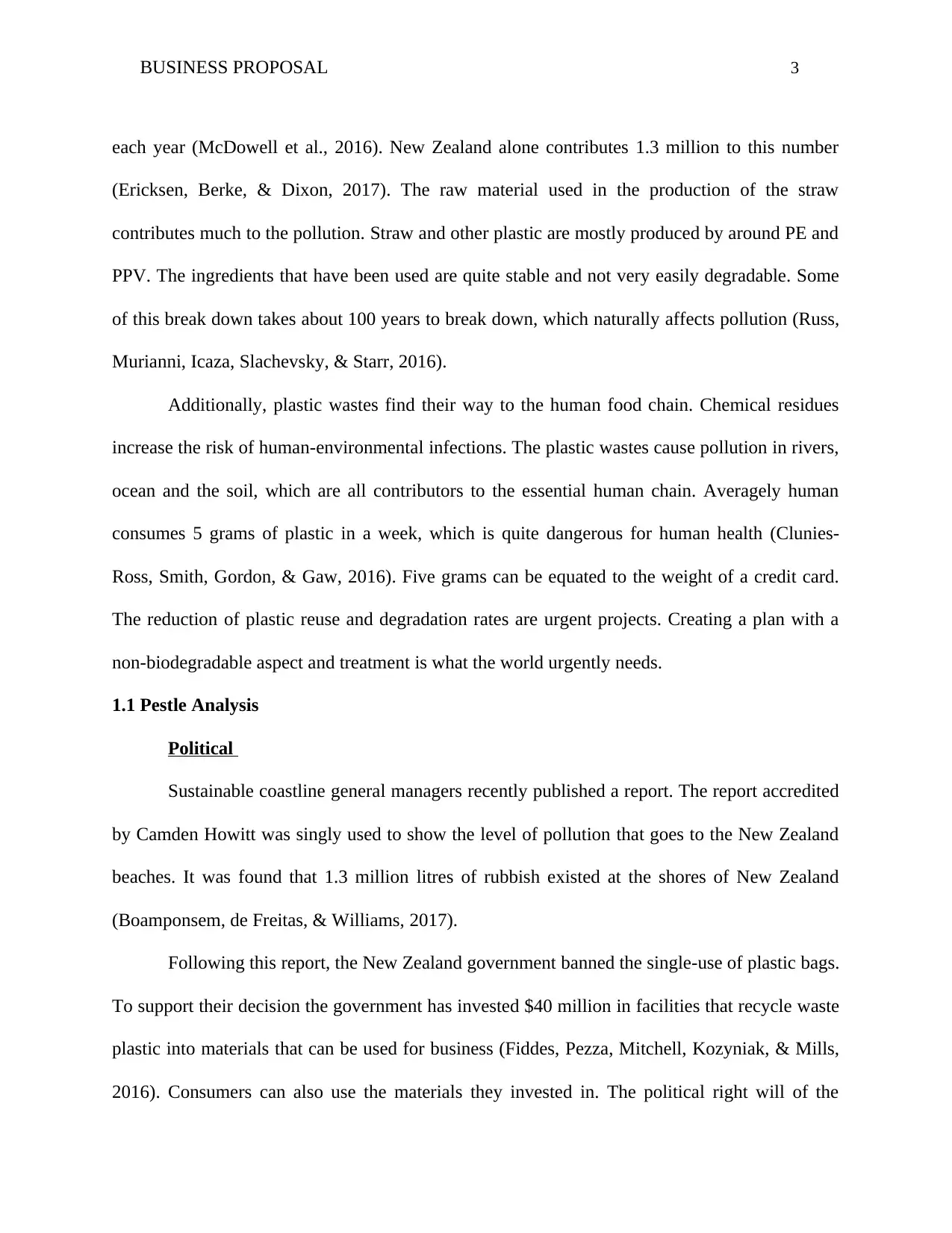
BUSINESS PROPOSAL 3
each year (McDowell et al., 2016). New Zealand alone contributes 1.3 million to this number
(Ericksen, Berke, & Dixon, 2017). The raw material used in the production of the straw
contributes much to the pollution. Straw and other plastic are mostly produced by around PE and
PPV. The ingredients that have been used are quite stable and not very easily degradable. Some
of this break down takes about 100 years to break down, which naturally affects pollution (Russ,
Murianni, Icaza, Slachevsky, & Starr, 2016).
Additionally, plastic wastes find their way to the human food chain. Chemical residues
increase the risk of human-environmental infections. The plastic wastes cause pollution in rivers,
ocean and the soil, which are all contributors to the essential human chain. Averagely human
consumes 5 grams of plastic in a week, which is quite dangerous for human health (Clunies-
Ross, Smith, Gordon, & Gaw, 2016). Five grams can be equated to the weight of a credit card.
The reduction of plastic reuse and degradation rates are urgent projects. Creating a plan with a
non-biodegradable aspect and treatment is what the world urgently needs.
1.1 Pestle Analysis
Political
Sustainable coastline general managers recently published a report. The report accredited
by Camden Howitt was singly used to show the level of pollution that goes to the New Zealand
beaches. It was found that 1.3 million litres of rubbish existed at the shores of New Zealand
(Boamponsem, de Freitas, & Williams, 2017).
Following this report, the New Zealand government banned the single-use of plastic bags.
To support their decision the government has invested $40 million in facilities that recycle waste
plastic into materials that can be used for business (Fiddes, Pezza, Mitchell, Kozyniak, & Mills,
2016). Consumers can also use the materials they invested in. The political right will of the
each year (McDowell et al., 2016). New Zealand alone contributes 1.3 million to this number
(Ericksen, Berke, & Dixon, 2017). The raw material used in the production of the straw
contributes much to the pollution. Straw and other plastic are mostly produced by around PE and
PPV. The ingredients that have been used are quite stable and not very easily degradable. Some
of this break down takes about 100 years to break down, which naturally affects pollution (Russ,
Murianni, Icaza, Slachevsky, & Starr, 2016).
Additionally, plastic wastes find their way to the human food chain. Chemical residues
increase the risk of human-environmental infections. The plastic wastes cause pollution in rivers,
ocean and the soil, which are all contributors to the essential human chain. Averagely human
consumes 5 grams of plastic in a week, which is quite dangerous for human health (Clunies-
Ross, Smith, Gordon, & Gaw, 2016). Five grams can be equated to the weight of a credit card.
The reduction of plastic reuse and degradation rates are urgent projects. Creating a plan with a
non-biodegradable aspect and treatment is what the world urgently needs.
1.1 Pestle Analysis
Political
Sustainable coastline general managers recently published a report. The report accredited
by Camden Howitt was singly used to show the level of pollution that goes to the New Zealand
beaches. It was found that 1.3 million litres of rubbish existed at the shores of New Zealand
(Boamponsem, de Freitas, & Williams, 2017).
Following this report, the New Zealand government banned the single-use of plastic bags.
To support their decision the government has invested $40 million in facilities that recycle waste
plastic into materials that can be used for business (Fiddes, Pezza, Mitchell, Kozyniak, & Mills,
2016). Consumers can also use the materials they invested in. The political right will of the

BUSINESS PROPOSAL 4
government is in alignment with the project. The project is investing in biodegradable cups that
will ensure the environment is safe. The production of plastic bags which is regulated by the
government helps maintain a firm standard of the laws. The same is infirm rules of the law. The
government requires any project that will single out plastics and faze them out. In our project, the
biodegradable cup ensures the reduction of plastics and most importantly, straws. In case the
government and the regulatory bodies might need to change anything, the project is flexible
enough. The entire project is in alignment will all the environmental and regulatory policies of
the New Zealand government.
Environment
Environmentally the project respects the effort of the global organizations to maintain
and save the planet environmental wise. A better part of industries in New Zealand recycles
paper, plastic, glass and metal. Additionally, the government hasn't placed any policy regulation
on hazardous waste management. In Auckland, for instance, the polluters have been made to pay
for household wastes (Fleming, Manning, & Ambrey, 2016). Paying for household waste is
expensive for many families; they instead would go for any preservative measures that are in
place. The Sippy cup project will be accepted by many households that aren't ready to pay for the
environmental non-gradable plastic charges. Application of the pay principle has entirely
reduced piling on landfills. Biodegradable cups used by coffee drinkers and those enjoying a
cold drink as proposed by the project is in alignment with the environmental levels as
recommended in PESTLE analysis (Duncan, 2016).
Social
The Sippy cup project dramatically impacts on the social factors as the social factors
impacts on it the same way. The project influences a lot of social support. The image of the
government is in alignment with the project. The project is investing in biodegradable cups that
will ensure the environment is safe. The production of plastic bags which is regulated by the
government helps maintain a firm standard of the laws. The same is infirm rules of the law. The
government requires any project that will single out plastics and faze them out. In our project, the
biodegradable cup ensures the reduction of plastics and most importantly, straws. In case the
government and the regulatory bodies might need to change anything, the project is flexible
enough. The entire project is in alignment will all the environmental and regulatory policies of
the New Zealand government.
Environment
Environmentally the project respects the effort of the global organizations to maintain
and save the planet environmental wise. A better part of industries in New Zealand recycles
paper, plastic, glass and metal. Additionally, the government hasn't placed any policy regulation
on hazardous waste management. In Auckland, for instance, the polluters have been made to pay
for household wastes (Fleming, Manning, & Ambrey, 2016). Paying for household waste is
expensive for many families; they instead would go for any preservative measures that are in
place. The Sippy cup project will be accepted by many households that aren't ready to pay for the
environmental non-gradable plastic charges. Application of the pay principle has entirely
reduced piling on landfills. Biodegradable cups used by coffee drinkers and those enjoying a
cold drink as proposed by the project is in alignment with the environmental levels as
recommended in PESTLE analysis (Duncan, 2016).
Social
The Sippy cup project dramatically impacts on the social factors as the social factors
impacts on it the same way. The project influences a lot of social support. The image of the
Secure Best Marks with AI Grader
Need help grading? Try our AI Grader for instant feedback on your assignments.
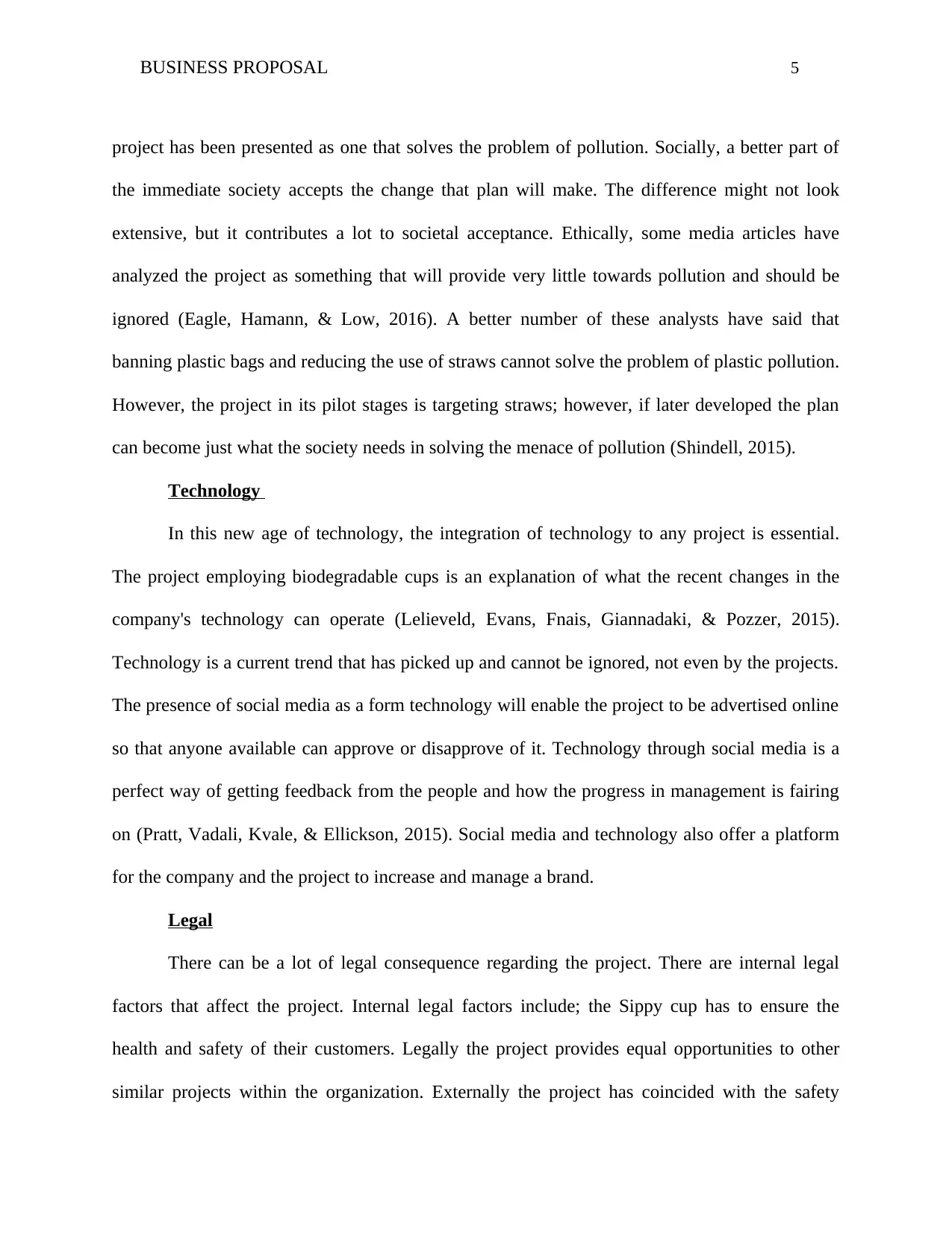
BUSINESS PROPOSAL 5
project has been presented as one that solves the problem of pollution. Socially, a better part of
the immediate society accepts the change that plan will make. The difference might not look
extensive, but it contributes a lot to societal acceptance. Ethically, some media articles have
analyzed the project as something that will provide very little towards pollution and should be
ignored (Eagle, Hamann, & Low, 2016). A better number of these analysts have said that
banning plastic bags and reducing the use of straws cannot solve the problem of plastic pollution.
However, the project in its pilot stages is targeting straws; however, if later developed the plan
can become just what the society needs in solving the menace of pollution (Shindell, 2015).
Technology
In this new age of technology, the integration of technology to any project is essential.
The project employing biodegradable cups is an explanation of what the recent changes in the
company's technology can operate (Lelieveld, Evans, Fnais, Giannadaki, & Pozzer, 2015).
Technology is a current trend that has picked up and cannot be ignored, not even by the projects.
The presence of social media as a form technology will enable the project to be advertised online
so that anyone available can approve or disapprove of it. Technology through social media is a
perfect way of getting feedback from the people and how the progress in management is fairing
on (Pratt, Vadali, Kvale, & Ellickson, 2015). Social media and technology also offer a platform
for the company and the project to increase and manage a brand.
Legal
There can be a lot of legal consequence regarding the project. There are internal legal
factors that affect the project. Internal legal factors include; the Sippy cup has to ensure the
health and safety of their customers. Legally the project provides equal opportunities to other
similar projects within the organization. Externally the project has coincided with the safety
project has been presented as one that solves the problem of pollution. Socially, a better part of
the immediate society accepts the change that plan will make. The difference might not look
extensive, but it contributes a lot to societal acceptance. Ethically, some media articles have
analyzed the project as something that will provide very little towards pollution and should be
ignored (Eagle, Hamann, & Low, 2016). A better number of these analysts have said that
banning plastic bags and reducing the use of straws cannot solve the problem of plastic pollution.
However, the project in its pilot stages is targeting straws; however, if later developed the plan
can become just what the society needs in solving the menace of pollution (Shindell, 2015).
Technology
In this new age of technology, the integration of technology to any project is essential.
The project employing biodegradable cups is an explanation of what the recent changes in the
company's technology can operate (Lelieveld, Evans, Fnais, Giannadaki, & Pozzer, 2015).
Technology is a current trend that has picked up and cannot be ignored, not even by the projects.
The presence of social media as a form technology will enable the project to be advertised online
so that anyone available can approve or disapprove of it. Technology through social media is a
perfect way of getting feedback from the people and how the progress in management is fairing
on (Pratt, Vadali, Kvale, & Ellickson, 2015). Social media and technology also offer a platform
for the company and the project to increase and manage a brand.
Legal
There can be a lot of legal consequence regarding the project. There are internal legal
factors that affect the project. Internal legal factors include; the Sippy cup has to ensure the
health and safety of their customers. Legally the project provides equal opportunities to other
similar projects within the organization. Externally the project has coincided with the safety

BUSINESS PROPOSAL 6
standards of the New Zealand law. It has also harmonized with the safety standards of the
production and labour laws. The Sippy cup project abides by the safety standards, and part of it
is government request that a legal binding should be created that links people to environmental
responsibility. If the government proceeds with the move that legally binds agreements, the
returns from the project will increase (Lorch, & Enlow, 2016).
Economic factors
The project is designed to compete with other active beverage producers economically.
Other competitors like star bucks. The Sippy cup is designed so that it will save a lot of cost on
pollution. Most people who are sympathetic to the pollution menace in the region will use the
cup, thereby economically increasing returns (Rao et al., 2017).
The project is designed to cost about $61.84 per 1000 units of production. A cup then
costs around $ 0.07 to produce. If the market reception is right, then the company is set to gain
from the Sippy cup project. Economically the project is feasible and viable.
Another step which the project becomes viable is through the fact that it is recyclable.
Since the cups will recycle, there will be no total loss (Kickhöfer, & Nagel, 2016). The company
instead of spending cost in creating new ones, they can re-create the already used one which will
save the company a lot of costs and will also serve the economic purpose of recycling achieved
by the company.
1.2 Critical and Reflective Thinking
Cost estimation as a limiting factor
It is difficult to estimate the cost of the Sippy cup project (Relich & Pawlewski, 2018).
The expectations of the proposal are based on solving an environmental problem (Relich &
Pawlewski, 2018). It then becomes quite challenging to estimate how the environmental solution
standards of the New Zealand law. It has also harmonized with the safety standards of the
production and labour laws. The Sippy cup project abides by the safety standards, and part of it
is government request that a legal binding should be created that links people to environmental
responsibility. If the government proceeds with the move that legally binds agreements, the
returns from the project will increase (Lorch, & Enlow, 2016).
Economic factors
The project is designed to compete with other active beverage producers economically.
Other competitors like star bucks. The Sippy cup is designed so that it will save a lot of cost on
pollution. Most people who are sympathetic to the pollution menace in the region will use the
cup, thereby economically increasing returns (Rao et al., 2017).
The project is designed to cost about $61.84 per 1000 units of production. A cup then
costs around $ 0.07 to produce. If the market reception is right, then the company is set to gain
from the Sippy cup project. Economically the project is feasible and viable.
Another step which the project becomes viable is through the fact that it is recyclable.
Since the cups will recycle, there will be no total loss (Kickhöfer, & Nagel, 2016). The company
instead of spending cost in creating new ones, they can re-create the already used one which will
save the company a lot of costs and will also serve the economic purpose of recycling achieved
by the company.
1.2 Critical and Reflective Thinking
Cost estimation as a limiting factor
It is difficult to estimate the cost of the Sippy cup project (Relich & Pawlewski, 2018).
The expectations of the proposal are based on solving an environmental problem (Relich &
Pawlewski, 2018). It then becomes quite challenging to estimate how the environmental solution
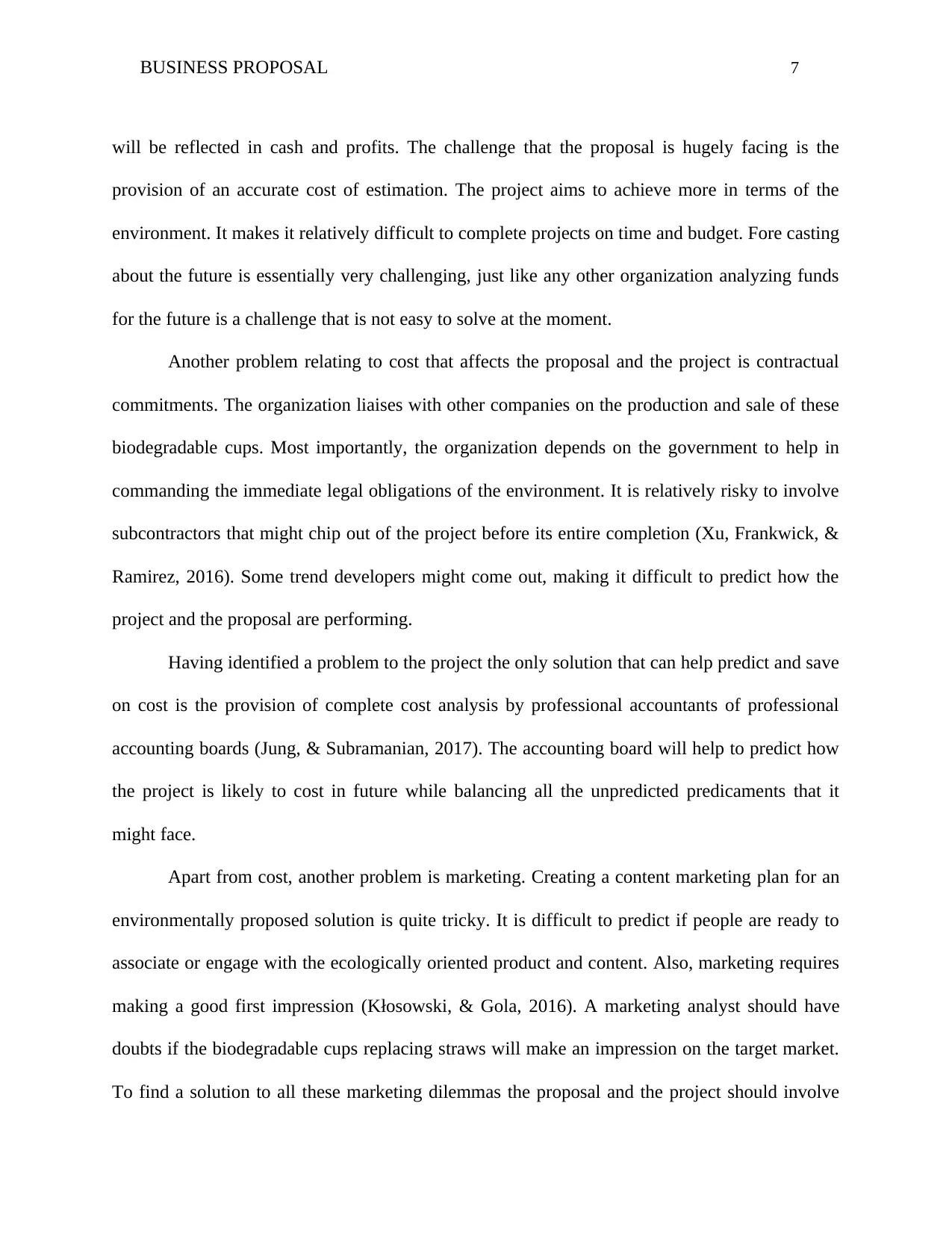
BUSINESS PROPOSAL 7
will be reflected in cash and profits. The challenge that the proposal is hugely facing is the
provision of an accurate cost of estimation. The project aims to achieve more in terms of the
environment. It makes it relatively difficult to complete projects on time and budget. Fore casting
about the future is essentially very challenging, just like any other organization analyzing funds
for the future is a challenge that is not easy to solve at the moment.
Another problem relating to cost that affects the proposal and the project is contractual
commitments. The organization liaises with other companies on the production and sale of these
biodegradable cups. Most importantly, the organization depends on the government to help in
commanding the immediate legal obligations of the environment. It is relatively risky to involve
subcontractors that might chip out of the project before its entire completion (Xu, Frankwick, &
Ramirez, 2016). Some trend developers might come out, making it difficult to predict how the
project and the proposal are performing.
Having identified a problem to the project the only solution that can help predict and save
on cost is the provision of complete cost analysis by professional accountants of professional
accounting boards (Jung, & Subramanian, 2017). The accounting board will help to predict how
the project is likely to cost in future while balancing all the unpredicted predicaments that it
might face.
Apart from cost, another problem is marketing. Creating a content marketing plan for an
environmentally proposed solution is quite tricky. It is difficult to predict if people are ready to
associate or engage with the ecologically oriented product and content. Also, marketing requires
making a good first impression (Kłosowski, & Gola, 2016). A marketing analyst should have
doubts if the biodegradable cups replacing straws will make an impression on the target market.
To find a solution to all these marketing dilemmas the proposal and the project should involve
will be reflected in cash and profits. The challenge that the proposal is hugely facing is the
provision of an accurate cost of estimation. The project aims to achieve more in terms of the
environment. It makes it relatively difficult to complete projects on time and budget. Fore casting
about the future is essentially very challenging, just like any other organization analyzing funds
for the future is a challenge that is not easy to solve at the moment.
Another problem relating to cost that affects the proposal and the project is contractual
commitments. The organization liaises with other companies on the production and sale of these
biodegradable cups. Most importantly, the organization depends on the government to help in
commanding the immediate legal obligations of the environment. It is relatively risky to involve
subcontractors that might chip out of the project before its entire completion (Xu, Frankwick, &
Ramirez, 2016). Some trend developers might come out, making it difficult to predict how the
project and the proposal are performing.
Having identified a problem to the project the only solution that can help predict and save
on cost is the provision of complete cost analysis by professional accountants of professional
accounting boards (Jung, & Subramanian, 2017). The accounting board will help to predict how
the project is likely to cost in future while balancing all the unpredicted predicaments that it
might face.
Apart from cost, another problem is marketing. Creating a content marketing plan for an
environmentally proposed solution is quite tricky. It is difficult to predict if people are ready to
associate or engage with the ecologically oriented product and content. Also, marketing requires
making a good first impression (Kłosowski, & Gola, 2016). A marketing analyst should have
doubts if the biodegradable cups replacing straws will make an impression on the target market.
To find a solution to all these marketing dilemmas the proposal and the project should involve
Paraphrase This Document
Need a fresh take? Get an instant paraphrase of this document with our AI Paraphraser
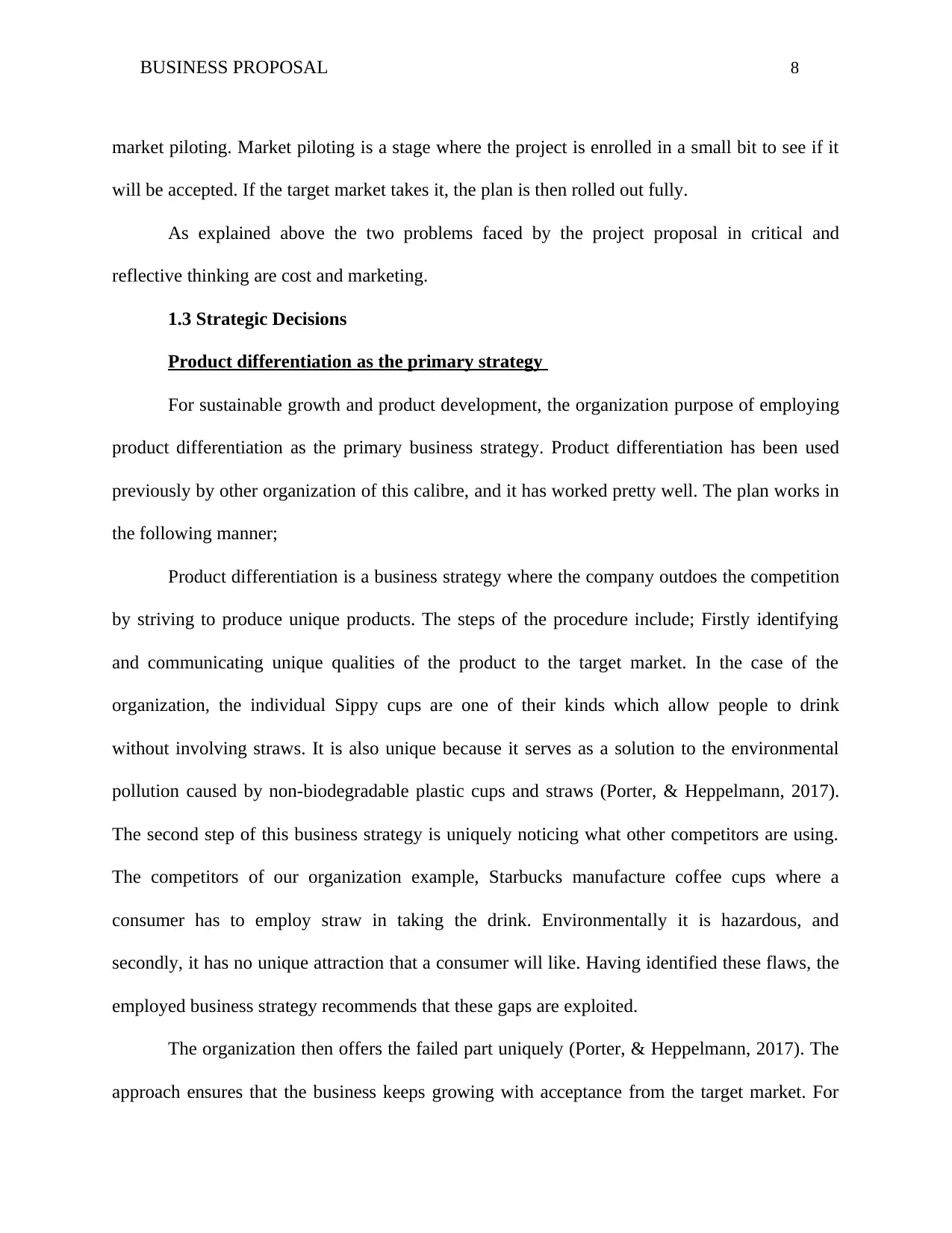
BUSINESS PROPOSAL 8
market piloting. Market piloting is a stage where the project is enrolled in a small bit to see if it
will be accepted. If the target market takes it, the plan is then rolled out fully.
As explained above the two problems faced by the project proposal in critical and
reflective thinking are cost and marketing.
1.3 Strategic Decisions
Product differentiation as the primary strategy
For sustainable growth and product development, the organization purpose of employing
product differentiation as the primary business strategy. Product differentiation has been used
previously by other organization of this calibre, and it has worked pretty well. The plan works in
the following manner;
Product differentiation is a business strategy where the company outdoes the competition
by striving to produce unique products. The steps of the procedure include; Firstly identifying
and communicating unique qualities of the product to the target market. In the case of the
organization, the individual Sippy cups are one of their kinds which allow people to drink
without involving straws. It is also unique because it serves as a solution to the environmental
pollution caused by non-biodegradable plastic cups and straws (Porter, & Heppelmann, 2017).
The second step of this business strategy is uniquely noticing what other competitors are using.
The competitors of our organization example, Starbucks manufacture coffee cups where a
consumer has to employ straw in taking the drink. Environmentally it is hazardous, and
secondly, it has no unique attraction that a consumer will like. Having identified these flaws, the
employed business strategy recommends that these gaps are exploited.
The organization then offers the failed part uniquely (Porter, & Heppelmann, 2017). The
approach ensures that the business keeps growing with acceptance from the target market. For
market piloting. Market piloting is a stage where the project is enrolled in a small bit to see if it
will be accepted. If the target market takes it, the plan is then rolled out fully.
As explained above the two problems faced by the project proposal in critical and
reflective thinking are cost and marketing.
1.3 Strategic Decisions
Product differentiation as the primary strategy
For sustainable growth and product development, the organization purpose of employing
product differentiation as the primary business strategy. Product differentiation has been used
previously by other organization of this calibre, and it has worked pretty well. The plan works in
the following manner;
Product differentiation is a business strategy where the company outdoes the competition
by striving to produce unique products. The steps of the procedure include; Firstly identifying
and communicating unique qualities of the product to the target market. In the case of the
organization, the individual Sippy cups are one of their kinds which allow people to drink
without involving straws. It is also unique because it serves as a solution to the environmental
pollution caused by non-biodegradable plastic cups and straws (Porter, & Heppelmann, 2017).
The second step of this business strategy is uniquely noticing what other competitors are using.
The competitors of our organization example, Starbucks manufacture coffee cups where a
consumer has to employ straw in taking the drink. Environmentally it is hazardous, and
secondly, it has no unique attraction that a consumer will like. Having identified these flaws, the
employed business strategy recommends that these gaps are exploited.
The organization then offers the failed part uniquely (Porter, & Heppelmann, 2017). The
approach ensures that the business keeps growing with acceptance from the target market. For
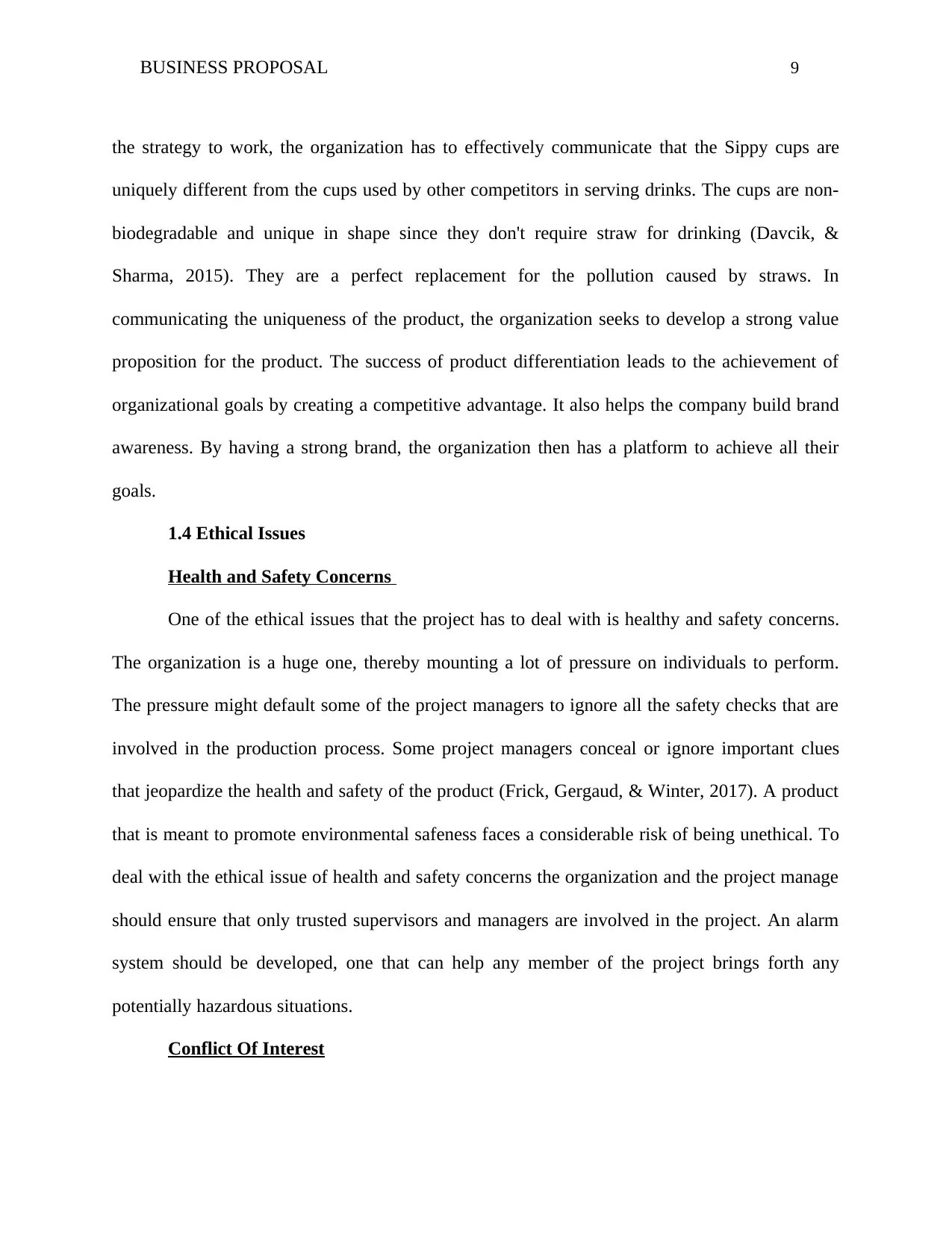
BUSINESS PROPOSAL 9
the strategy to work, the organization has to effectively communicate that the Sippy cups are
uniquely different from the cups used by other competitors in serving drinks. The cups are non-
biodegradable and unique in shape since they don't require straw for drinking (Davcik, &
Sharma, 2015). They are a perfect replacement for the pollution caused by straws. In
communicating the uniqueness of the product, the organization seeks to develop a strong value
proposition for the product. The success of product differentiation leads to the achievement of
organizational goals by creating a competitive advantage. It also helps the company build brand
awareness. By having a strong brand, the organization then has a platform to achieve all their
goals.
1.4 Ethical Issues
Health and Safety Concerns
One of the ethical issues that the project has to deal with is healthy and safety concerns.
The organization is a huge one, thereby mounting a lot of pressure on individuals to perform.
The pressure might default some of the project managers to ignore all the safety checks that are
involved in the production process. Some project managers conceal or ignore important clues
that jeopardize the health and safety of the product (Frick, Gergaud, & Winter, 2017). A product
that is meant to promote environmental safeness faces a considerable risk of being unethical. To
deal with the ethical issue of health and safety concerns the organization and the project manage
should ensure that only trusted supervisors and managers are involved in the project. An alarm
system should be developed, one that can help any member of the project brings forth any
potentially hazardous situations.
Conflict Of Interest
the strategy to work, the organization has to effectively communicate that the Sippy cups are
uniquely different from the cups used by other competitors in serving drinks. The cups are non-
biodegradable and unique in shape since they don't require straw for drinking (Davcik, &
Sharma, 2015). They are a perfect replacement for the pollution caused by straws. In
communicating the uniqueness of the product, the organization seeks to develop a strong value
proposition for the product. The success of product differentiation leads to the achievement of
organizational goals by creating a competitive advantage. It also helps the company build brand
awareness. By having a strong brand, the organization then has a platform to achieve all their
goals.
1.4 Ethical Issues
Health and Safety Concerns
One of the ethical issues that the project has to deal with is healthy and safety concerns.
The organization is a huge one, thereby mounting a lot of pressure on individuals to perform.
The pressure might default some of the project managers to ignore all the safety checks that are
involved in the production process. Some project managers conceal or ignore important clues
that jeopardize the health and safety of the product (Frick, Gergaud, & Winter, 2017). A product
that is meant to promote environmental safeness faces a considerable risk of being unethical. To
deal with the ethical issue of health and safety concerns the organization and the project manage
should ensure that only trusted supervisors and managers are involved in the project. An alarm
system should be developed, one that can help any member of the project brings forth any
potentially hazardous situations.
Conflict Of Interest
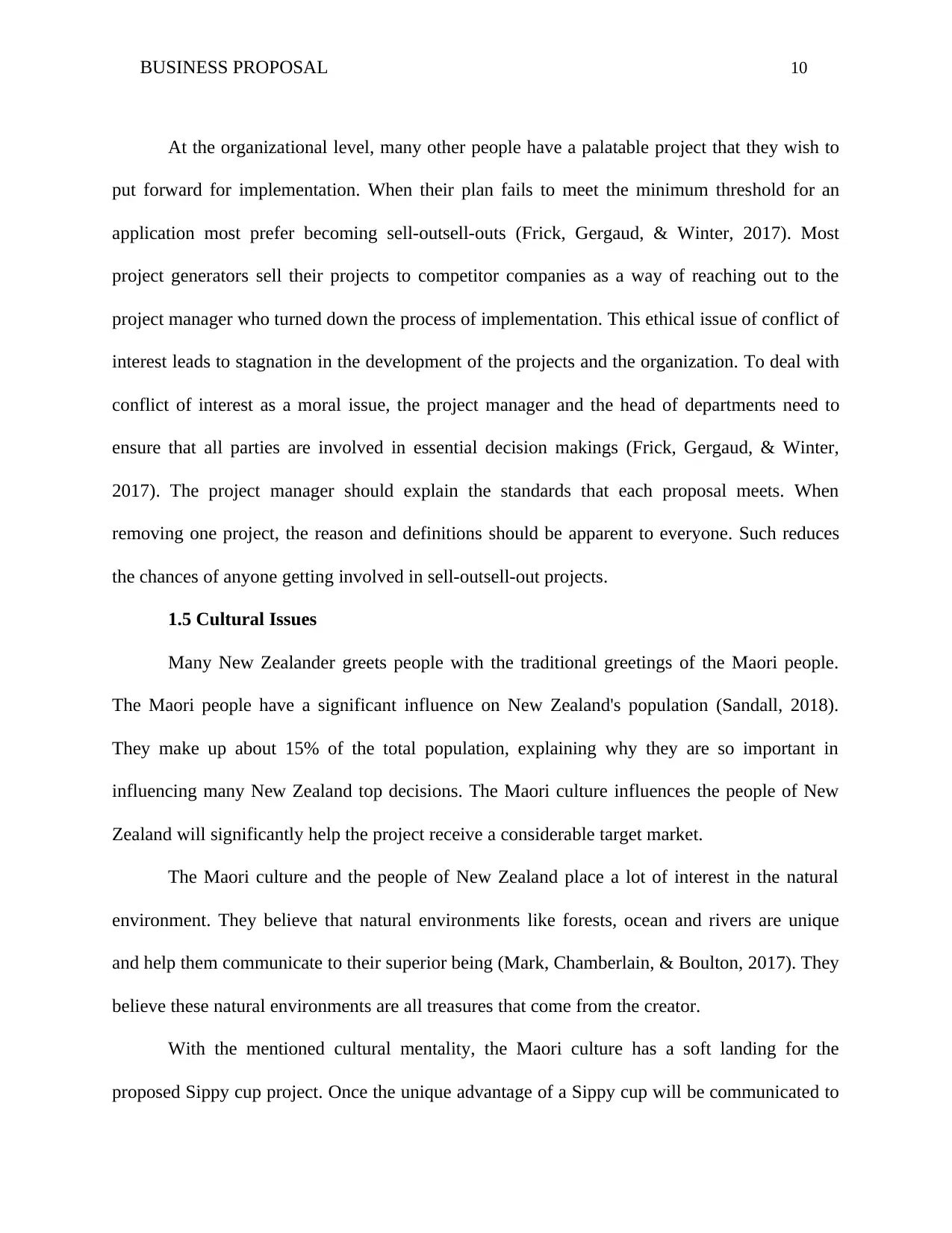
BUSINESS PROPOSAL 10
At the organizational level, many other people have a palatable project that they wish to
put forward for implementation. When their plan fails to meet the minimum threshold for an
application most prefer becoming sell-outsell-outs (Frick, Gergaud, & Winter, 2017). Most
project generators sell their projects to competitor companies as a way of reaching out to the
project manager who turned down the process of implementation. This ethical issue of conflict of
interest leads to stagnation in the development of the projects and the organization. To deal with
conflict of interest as a moral issue, the project manager and the head of departments need to
ensure that all parties are involved in essential decision makings (Frick, Gergaud, & Winter,
2017). The project manager should explain the standards that each proposal meets. When
removing one project, the reason and definitions should be apparent to everyone. Such reduces
the chances of anyone getting involved in sell-outsell-out projects.
1.5 Cultural Issues
Many New Zealander greets people with the traditional greetings of the Maori people.
The Maori people have a significant influence on New Zealand's population (Sandall, 2018).
They make up about 15% of the total population, explaining why they are so important in
influencing many New Zealand top decisions. The Maori culture influences the people of New
Zealand will significantly help the project receive a considerable target market.
The Maori culture and the people of New Zealand place a lot of interest in the natural
environment. They believe that natural environments like forests, ocean and rivers are unique
and help them communicate to their superior being (Mark, Chamberlain, & Boulton, 2017). They
believe these natural environments are all treasures that come from the creator.
With the mentioned cultural mentality, the Maori culture has a soft landing for the
proposed Sippy cup project. Once the unique advantage of a Sippy cup will be communicated to
At the organizational level, many other people have a palatable project that they wish to
put forward for implementation. When their plan fails to meet the minimum threshold for an
application most prefer becoming sell-outsell-outs (Frick, Gergaud, & Winter, 2017). Most
project generators sell their projects to competitor companies as a way of reaching out to the
project manager who turned down the process of implementation. This ethical issue of conflict of
interest leads to stagnation in the development of the projects and the organization. To deal with
conflict of interest as a moral issue, the project manager and the head of departments need to
ensure that all parties are involved in essential decision makings (Frick, Gergaud, & Winter,
2017). The project manager should explain the standards that each proposal meets. When
removing one project, the reason and definitions should be apparent to everyone. Such reduces
the chances of anyone getting involved in sell-outsell-out projects.
1.5 Cultural Issues
Many New Zealander greets people with the traditional greetings of the Maori people.
The Maori people have a significant influence on New Zealand's population (Sandall, 2018).
They make up about 15% of the total population, explaining why they are so important in
influencing many New Zealand top decisions. The Maori culture influences the people of New
Zealand will significantly help the project receive a considerable target market.
The Maori culture and the people of New Zealand place a lot of interest in the natural
environment. They believe that natural environments like forests, ocean and rivers are unique
and help them communicate to their superior being (Mark, Chamberlain, & Boulton, 2017). They
believe these natural environments are all treasures that come from the creator.
With the mentioned cultural mentality, the Maori culture has a soft landing for the
proposed Sippy cup project. Once the unique advantage of a Sippy cup will be communicated to
Secure Best Marks with AI Grader
Need help grading? Try our AI Grader for instant feedback on your assignments.

BUSINESS PROPOSAL 11
them, and they realize it contributes to the conservation of the natural environment, they will
prefer to use it. There is logic in believing that the Maori will do away with straws which have
been affecting their natural environment. They can uniquely do so by supporting the use of the
new Sippy cups.
Additionally, their culture will adequately help in spreading the message across New
Zealand. Having earlier explained that the Maori culture influences the behaviour of the
NewZealanders if they accept the sippy cup a good number of the people in New Zealand will
take it too.
In totality, the Maori culture contributes to the project by providing a more
comprehensive and ready target market.
1.6 Management Strategy
If the proposal is to be adapted, it will use the matrix structure management strategy. The
structure is a combination of the functional and divisional management unit of the organization.
The management chain of command is decentralized, allowing room for autonomy. The
decentralized decision-making system also gives rise to inter-departmental interactions regarding
the new product. Communication about the product across all the departments will lead to higher
productivity and innovation. The adopted management structure is uniquely expensive, but it is
worth the implementation. It might not also work if vertical functions affect the production lines.
Adaptation of matrix structure to the proposal contributes to the immediate community
(Schnetler, Steyn, & van Staden, 2015). It does participate in the following way: The financial
analyst works closely with the different units and understands the immediate responsibility that
the organization needs to set to the community. Regular meetings are then uniquely held on how
issues of environment and its conservation can be reached. The proposal of Sippy cups can be an
them, and they realize it contributes to the conservation of the natural environment, they will
prefer to use it. There is logic in believing that the Maori will do away with straws which have
been affecting their natural environment. They can uniquely do so by supporting the use of the
new Sippy cups.
Additionally, their culture will adequately help in spreading the message across New
Zealand. Having earlier explained that the Maori culture influences the behaviour of the
NewZealanders if they accept the sippy cup a good number of the people in New Zealand will
take it too.
In totality, the Maori culture contributes to the project by providing a more
comprehensive and ready target market.
1.6 Management Strategy
If the proposal is to be adapted, it will use the matrix structure management strategy. The
structure is a combination of the functional and divisional management unit of the organization.
The management chain of command is decentralized, allowing room for autonomy. The
decentralized decision-making system also gives rise to inter-departmental interactions regarding
the new product. Communication about the product across all the departments will lead to higher
productivity and innovation. The adopted management structure is uniquely expensive, but it is
worth the implementation. It might not also work if vertical functions affect the production lines.
Adaptation of matrix structure to the proposal contributes to the immediate community
(Schnetler, Steyn, & van Staden, 2015). It does participate in the following way: The financial
analyst works closely with the different units and understands the immediate responsibility that
the organization needs to set to the community. Regular meetings are then uniquely held on how
issues of environment and its conservation can be reached. The proposal of Sippy cups can be an
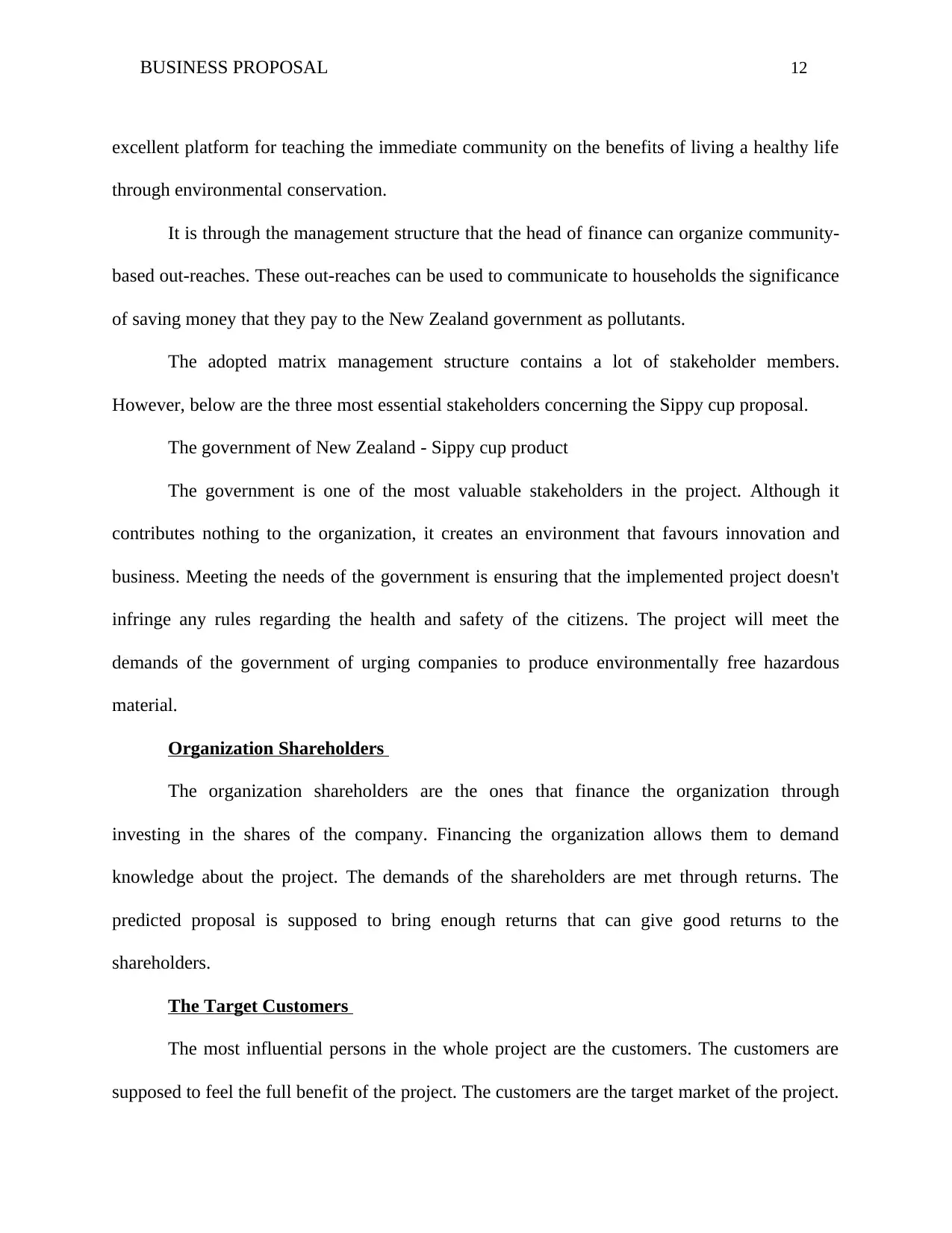
BUSINESS PROPOSAL 12
excellent platform for teaching the immediate community on the benefits of living a healthy life
through environmental conservation.
It is through the management structure that the head of finance can organize community-
based out-reaches. These out-reaches can be used to communicate to households the significance
of saving money that they pay to the New Zealand government as pollutants.
The adopted matrix management structure contains a lot of stakeholder members.
However, below are the three most essential stakeholders concerning the Sippy cup proposal.
The government of New Zealand - Sippy cup product
The government is one of the most valuable stakeholders in the project. Although it
contributes nothing to the organization, it creates an environment that favours innovation and
business. Meeting the needs of the government is ensuring that the implemented project doesn't
infringe any rules regarding the health and safety of the citizens. The project will meet the
demands of the government of urging companies to produce environmentally free hazardous
material.
Organization Shareholders
The organization shareholders are the ones that finance the organization through
investing in the shares of the company. Financing the organization allows them to demand
knowledge about the project. The demands of the shareholders are met through returns. The
predicted proposal is supposed to bring enough returns that can give good returns to the
shareholders.
The Target Customers
The most influential persons in the whole project are the customers. The customers are
supposed to feel the full benefit of the project. The customers are the target market of the project.
excellent platform for teaching the immediate community on the benefits of living a healthy life
through environmental conservation.
It is through the management structure that the head of finance can organize community-
based out-reaches. These out-reaches can be used to communicate to households the significance
of saving money that they pay to the New Zealand government as pollutants.
The adopted matrix management structure contains a lot of stakeholder members.
However, below are the three most essential stakeholders concerning the Sippy cup proposal.
The government of New Zealand - Sippy cup product
The government is one of the most valuable stakeholders in the project. Although it
contributes nothing to the organization, it creates an environment that favours innovation and
business. Meeting the needs of the government is ensuring that the implemented project doesn't
infringe any rules regarding the health and safety of the citizens. The project will meet the
demands of the government of urging companies to produce environmentally free hazardous
material.
Organization Shareholders
The organization shareholders are the ones that finance the organization through
investing in the shares of the company. Financing the organization allows them to demand
knowledge about the project. The demands of the shareholders are met through returns. The
predicted proposal is supposed to bring enough returns that can give good returns to the
shareholders.
The Target Customers
The most influential persons in the whole project are the customers. The customers are
supposed to feel the full benefit of the project. The customers are the target market of the project.
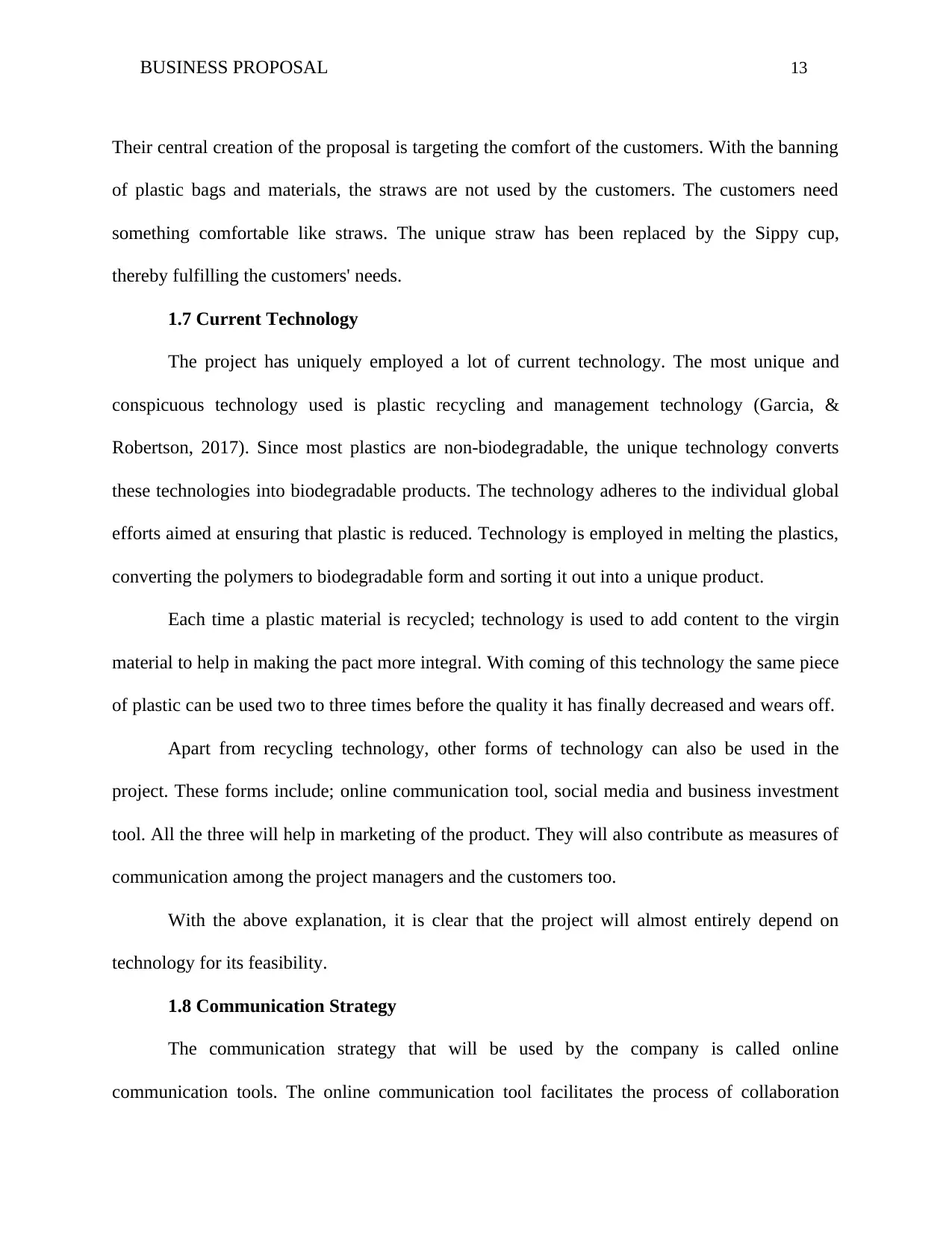
BUSINESS PROPOSAL 13
Their central creation of the proposal is targeting the comfort of the customers. With the banning
of plastic bags and materials, the straws are not used by the customers. The customers need
something comfortable like straws. The unique straw has been replaced by the Sippy cup,
thereby fulfilling the customers' needs.
1.7 Current Technology
The project has uniquely employed a lot of current technology. The most unique and
conspicuous technology used is plastic recycling and management technology (Garcia, &
Robertson, 2017). Since most plastics are non-biodegradable, the unique technology converts
these technologies into biodegradable products. The technology adheres to the individual global
efforts aimed at ensuring that plastic is reduced. Technology is employed in melting the plastics,
converting the polymers to biodegradable form and sorting it out into a unique product.
Each time a plastic material is recycled; technology is used to add content to the virgin
material to help in making the pact more integral. With coming of this technology the same piece
of plastic can be used two to three times before the quality it has finally decreased and wears off.
Apart from recycling technology, other forms of technology can also be used in the
project. These forms include; online communication tool, social media and business investment
tool. All the three will help in marketing of the product. They will also contribute as measures of
communication among the project managers and the customers too.
With the above explanation, it is clear that the project will almost entirely depend on
technology for its feasibility.
1.8 Communication Strategy
The communication strategy that will be used by the company is called online
communication tools. The online communication tool facilitates the process of collaboration
Their central creation of the proposal is targeting the comfort of the customers. With the banning
of plastic bags and materials, the straws are not used by the customers. The customers need
something comfortable like straws. The unique straw has been replaced by the Sippy cup,
thereby fulfilling the customers' needs.
1.7 Current Technology
The project has uniquely employed a lot of current technology. The most unique and
conspicuous technology used is plastic recycling and management technology (Garcia, &
Robertson, 2017). Since most plastics are non-biodegradable, the unique technology converts
these technologies into biodegradable products. The technology adheres to the individual global
efforts aimed at ensuring that plastic is reduced. Technology is employed in melting the plastics,
converting the polymers to biodegradable form and sorting it out into a unique product.
Each time a plastic material is recycled; technology is used to add content to the virgin
material to help in making the pact more integral. With coming of this technology the same piece
of plastic can be used two to three times before the quality it has finally decreased and wears off.
Apart from recycling technology, other forms of technology can also be used in the
project. These forms include; online communication tool, social media and business investment
tool. All the three will help in marketing of the product. They will also contribute as measures of
communication among the project managers and the customers too.
With the above explanation, it is clear that the project will almost entirely depend on
technology for its feasibility.
1.8 Communication Strategy
The communication strategy that will be used by the company is called online
communication tools. The online communication tool facilitates the process of collaboration
Paraphrase This Document
Need a fresh take? Get an instant paraphrase of this document with our AI Paraphraser
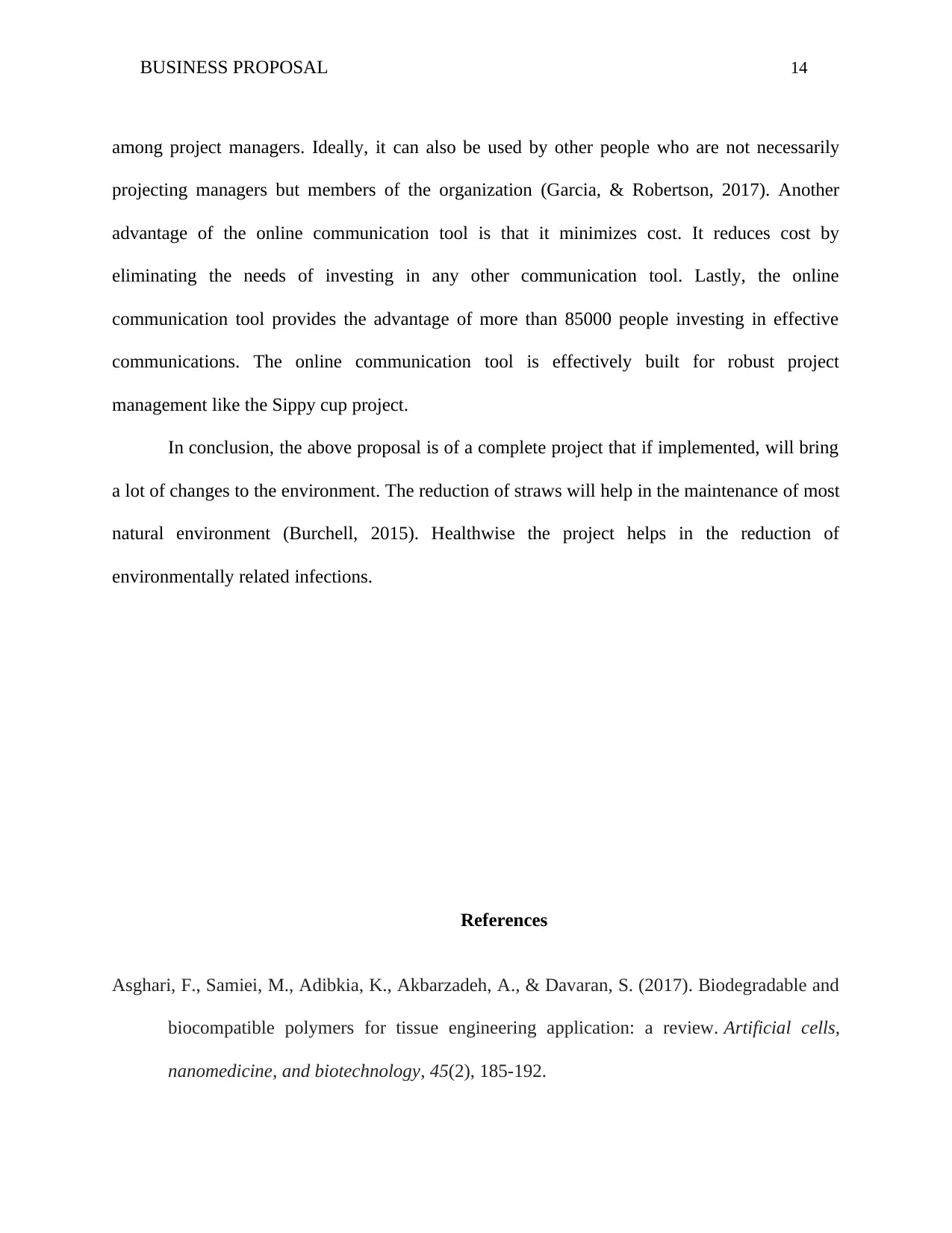
BUSINESS PROPOSAL 14
among project managers. Ideally, it can also be used by other people who are not necessarily
projecting managers but members of the organization (Garcia, & Robertson, 2017). Another
advantage of the online communication tool is that it minimizes cost. It reduces cost by
eliminating the needs of investing in any other communication tool. Lastly, the online
communication tool provides the advantage of more than 85000 people investing in effective
communications. The online communication tool is effectively built for robust project
management like the Sippy cup project.
In conclusion, the above proposal is of a complete project that if implemented, will bring
a lot of changes to the environment. The reduction of straws will help in the maintenance of most
natural environment (Burchell, 2015). Healthwise the project helps in the reduction of
environmentally related infections.
References
Asghari, F., Samiei, M., Adibkia, K., Akbarzadeh, A., & Davaran, S. (2017). Biodegradable and
biocompatible polymers for tissue engineering application: a review. Artificial cells,
nanomedicine, and biotechnology, 45(2), 185-192.
among project managers. Ideally, it can also be used by other people who are not necessarily
projecting managers but members of the organization (Garcia, & Robertson, 2017). Another
advantage of the online communication tool is that it minimizes cost. It reduces cost by
eliminating the needs of investing in any other communication tool. Lastly, the online
communication tool provides the advantage of more than 85000 people investing in effective
communications. The online communication tool is effectively built for robust project
management like the Sippy cup project.
In conclusion, the above proposal is of a complete project that if implemented, will bring
a lot of changes to the environment. The reduction of straws will help in the maintenance of most
natural environment (Burchell, 2015). Healthwise the project helps in the reduction of
environmentally related infections.
References
Asghari, F., Samiei, M., Adibkia, K., Akbarzadeh, A., & Davaran, S. (2017). Biodegradable and
biocompatible polymers for tissue engineering application: a review. Artificial cells,
nanomedicine, and biotechnology, 45(2), 185-192.

BUSINESS PROPOSAL 15
Boamponsem, L. K., de Freitas, C. R., & Williams, D. (2017). Source apportionment of air
pollutants in the Greater Auckland Region of New Zealand using receptor models and
elemental levels in the lichen, Parmotrema reticulatum. Atmospheric Pollution
Research, 8(1), 101-113.
Burchell, K. (2015). Tasking the everyday: Where mobile and online communication take
time. Mobile Media & Communication, 3(1), 36-52.
Clunies-Ross, P. J., Smith, G. P. S., Gordon, K. C., & Gaw, S. (2016). Synthetic shorelines in
New Zealand? Quantification and characterisation of microplastic pollution on
Canterbury's coastlines. New Zealand Journal of Marine and Freshwater
Research, 50(2), 317-325.
Davcik, N. S., & Sharma, P. (2015). Impact of product differentiation, marketing investments
and brand equity on pricing strategies: A brand level investigation. European Journal of
Marketing, 49(5/6), 760-781.
Duncan, R. (2016). Ways of knowing–out-of-sync or incompatible? Framing water quality and
farmers’ encounters with science in the regulation of non-point source pollution in the
Canterbury region of New Zealand. Environmental Science & Policy, 55, 151-157.
Eagle, L., Hamann, M., & Low, D. R. (2016). The role of social marketing, marine turtles and
sustainable tourism in reducing plastic pollution. Marine pollution bulletin, 107(1), 324-
332.
Ericksen, N. J., Berke, P. R., & Dixon, J. E. (2017). Plan-making for sustainability: The New
Zealand experience. Routledge.112-114
Boamponsem, L. K., de Freitas, C. R., & Williams, D. (2017). Source apportionment of air
pollutants in the Greater Auckland Region of New Zealand using receptor models and
elemental levels in the lichen, Parmotrema reticulatum. Atmospheric Pollution
Research, 8(1), 101-113.
Burchell, K. (2015). Tasking the everyday: Where mobile and online communication take
time. Mobile Media & Communication, 3(1), 36-52.
Clunies-Ross, P. J., Smith, G. P. S., Gordon, K. C., & Gaw, S. (2016). Synthetic shorelines in
New Zealand? Quantification and characterisation of microplastic pollution on
Canterbury's coastlines. New Zealand Journal of Marine and Freshwater
Research, 50(2), 317-325.
Davcik, N. S., & Sharma, P. (2015). Impact of product differentiation, marketing investments
and brand equity on pricing strategies: A brand level investigation. European Journal of
Marketing, 49(5/6), 760-781.
Duncan, R. (2016). Ways of knowing–out-of-sync or incompatible? Framing water quality and
farmers’ encounters with science in the regulation of non-point source pollution in the
Canterbury region of New Zealand. Environmental Science & Policy, 55, 151-157.
Eagle, L., Hamann, M., & Low, D. R. (2016). The role of social marketing, marine turtles and
sustainable tourism in reducing plastic pollution. Marine pollution bulletin, 107(1), 324-
332.
Ericksen, N. J., Berke, P. R., & Dixon, J. E. (2017). Plan-making for sustainability: The New
Zealand experience. Routledge.112-114

BUSINESS PROPOSAL 16
Fiddes, S. L., Pezza, A. B., Mitchell, T. A., Kozyniak, K., & Mills, D. (2016). Synoptic weather
evolution and climate drivers associated with winter air pollution in New
Zealand. Atmospheric Pollution Research, 7(6), 1082-1089.
Fleming, C. M., Manning, M., & Ambrey, C. L. (2016). Crime, greenspace and life satisfaction:
An evaluation of the New Zealand experience. Landscape and Urban Planning, 149, 1-
10.
Foote, K. J., Joy, M. K., & Death, R. G. (2015). New Zealand dairy farming: milking our
environment for all its worth. Environmental management, 56(3), 709-720.
Frick, B., Gergaud, O., & Winter, P. (2017). The Revenue Potential of Product Differentiation:
Empirical Evidence From the Croatian Restaurant Industry. Journal of Gastronomy and
Tourism, 2(4), 259-271.
Garcia, J. M., & Robertson, M. L. (2017). The future of plastics recycling. Science, 358(6365),
870-872.
Jung, H. W. H., & Subramanian, A. (2017). CEO talent, CEO compensation, and product market
competition. Journal of Financial Economics, 125(1), 48-71.
Kickhöfer, B., & Nagel, K. (2016). Towards high-resolution first-best air pollution
tolls. Networks and Spatial Economics, 16(1), 175-198.
Kłosowski, G., & Gola, A. (2016, September). Risk-based estimation of manufacturing order
costs with artificial intelligence. In 2016 Federated Conference on Computer Science and
Information Systems (FedCSIS) (pp. 729-732). IEEE.
Laycock, B., Nikolić, M., Colwell, J. M., Gauthier, E., Halley, P., Bottle, S., & George, G.
(2017). Lifetime prediction of biodegradable polymers. Progress in Polymer Science, 71,
144-189.
Fiddes, S. L., Pezza, A. B., Mitchell, T. A., Kozyniak, K., & Mills, D. (2016). Synoptic weather
evolution and climate drivers associated with winter air pollution in New
Zealand. Atmospheric Pollution Research, 7(6), 1082-1089.
Fleming, C. M., Manning, M., & Ambrey, C. L. (2016). Crime, greenspace and life satisfaction:
An evaluation of the New Zealand experience. Landscape and Urban Planning, 149, 1-
10.
Foote, K. J., Joy, M. K., & Death, R. G. (2015). New Zealand dairy farming: milking our
environment for all its worth. Environmental management, 56(3), 709-720.
Frick, B., Gergaud, O., & Winter, P. (2017). The Revenue Potential of Product Differentiation:
Empirical Evidence From the Croatian Restaurant Industry. Journal of Gastronomy and
Tourism, 2(4), 259-271.
Garcia, J. M., & Robertson, M. L. (2017). The future of plastics recycling. Science, 358(6365),
870-872.
Jung, H. W. H., & Subramanian, A. (2017). CEO talent, CEO compensation, and product market
competition. Journal of Financial Economics, 125(1), 48-71.
Kickhöfer, B., & Nagel, K. (2016). Towards high-resolution first-best air pollution
tolls. Networks and Spatial Economics, 16(1), 175-198.
Kłosowski, G., & Gola, A. (2016, September). Risk-based estimation of manufacturing order
costs with artificial intelligence. In 2016 Federated Conference on Computer Science and
Information Systems (FedCSIS) (pp. 729-732). IEEE.
Laycock, B., Nikolić, M., Colwell, J. M., Gauthier, E., Halley, P., Bottle, S., & George, G.
(2017). Lifetime prediction of biodegradable polymers. Progress in Polymer Science, 71,
144-189.
Secure Best Marks with AI Grader
Need help grading? Try our AI Grader for instant feedback on your assignments.
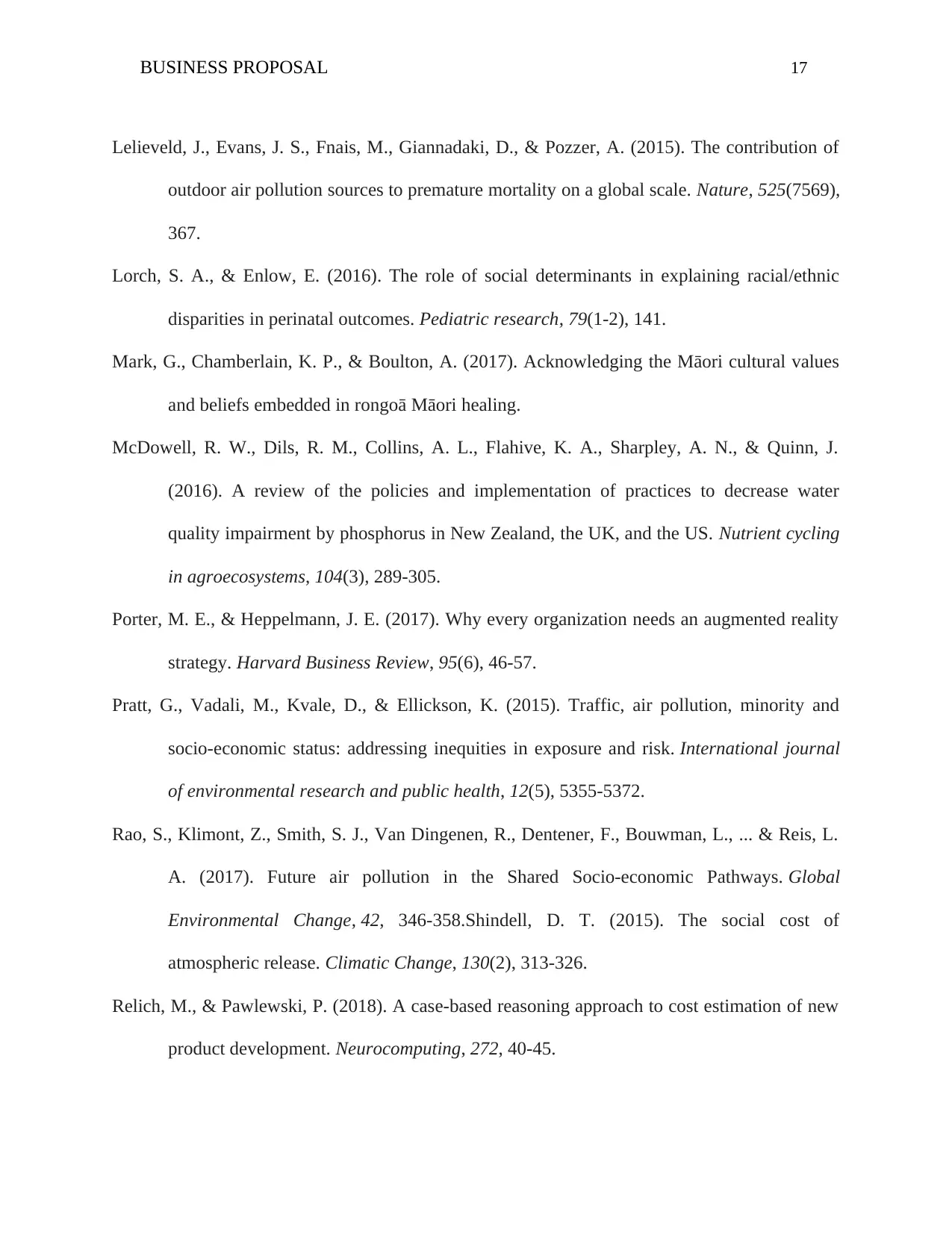
BUSINESS PROPOSAL 17
Lelieveld, J., Evans, J. S., Fnais, M., Giannadaki, D., & Pozzer, A. (2015). The contribution of
outdoor air pollution sources to premature mortality on a global scale. Nature, 525(7569),
367.
Lorch, S. A., & Enlow, E. (2016). The role of social determinants in explaining racial/ethnic
disparities in perinatal outcomes. Pediatric research, 79(1-2), 141.
Mark, G., Chamberlain, K. P., & Boulton, A. (2017). Acknowledging the Māori cultural values
and beliefs embedded in rongoā Māori healing.
McDowell, R. W., Dils, R. M., Collins, A. L., Flahive, K. A., Sharpley, A. N., & Quinn, J.
(2016). A review of the policies and implementation of practices to decrease water
quality impairment by phosphorus in New Zealand, the UK, and the US. Nutrient cycling
in agroecosystems, 104(3), 289-305.
Porter, M. E., & Heppelmann, J. E. (2017). Why every organization needs an augmented reality
strategy. Harvard Business Review, 95(6), 46-57.
Pratt, G., Vadali, M., Kvale, D., & Ellickson, K. (2015). Traffic, air pollution, minority and
socio-economic status: addressing inequities in exposure and risk. International journal
of environmental research and public health, 12(5), 5355-5372.
Rao, S., Klimont, Z., Smith, S. J., Van Dingenen, R., Dentener, F., Bouwman, L., ... & Reis, L.
A. (2017). Future air pollution in the Shared Socio-economic Pathways. Global
Environmental Change, 42, 346-358.Shindell, D. T. (2015). The social cost of
atmospheric release. Climatic Change, 130(2), 313-326.
Relich, M., & Pawlewski, P. (2018). A case-based reasoning approach to cost estimation of new
product development. Neurocomputing, 272, 40-45.
Lelieveld, J., Evans, J. S., Fnais, M., Giannadaki, D., & Pozzer, A. (2015). The contribution of
outdoor air pollution sources to premature mortality on a global scale. Nature, 525(7569),
367.
Lorch, S. A., & Enlow, E. (2016). The role of social determinants in explaining racial/ethnic
disparities in perinatal outcomes. Pediatric research, 79(1-2), 141.
Mark, G., Chamberlain, K. P., & Boulton, A. (2017). Acknowledging the Māori cultural values
and beliefs embedded in rongoā Māori healing.
McDowell, R. W., Dils, R. M., Collins, A. L., Flahive, K. A., Sharpley, A. N., & Quinn, J.
(2016). A review of the policies and implementation of practices to decrease water
quality impairment by phosphorus in New Zealand, the UK, and the US. Nutrient cycling
in agroecosystems, 104(3), 289-305.
Porter, M. E., & Heppelmann, J. E. (2017). Why every organization needs an augmented reality
strategy. Harvard Business Review, 95(6), 46-57.
Pratt, G., Vadali, M., Kvale, D., & Ellickson, K. (2015). Traffic, air pollution, minority and
socio-economic status: addressing inequities in exposure and risk. International journal
of environmental research and public health, 12(5), 5355-5372.
Rao, S., Klimont, Z., Smith, S. J., Van Dingenen, R., Dentener, F., Bouwman, L., ... & Reis, L.
A. (2017). Future air pollution in the Shared Socio-economic Pathways. Global
Environmental Change, 42, 346-358.Shindell, D. T. (2015). The social cost of
atmospheric release. Climatic Change, 130(2), 313-326.
Relich, M., & Pawlewski, P. (2018). A case-based reasoning approach to cost estimation of new
product development. Neurocomputing, 272, 40-45.

BUSINESS PROPOSAL 18
Russ, T. C., Murianni, L., Icaza, G., Slachevsky, A., & Starr, J. M. (2016). Geographical
variation in dementia mortality in italy, new zealand, and chile: The impact of latitude,
Vitamin D, and air pollution. Dementia and geriatric cognitive disorders, 42(1-2), 31-41.
Sandall, R. (2018). The culture cult: designer tribalism and other essays. Routledge.113-114
Schnetler, R., Steyn, H., & van Staden, P. J. (2015). Characteristics of matrix structures, and
their effects on project success. South African Journal of Industrial Engineering, 26(1),
11-26.
Xu, Z., Frankwick, G. L., & Ramirez, E. (2016). Effects of big data analytics and traditional
marketing analytics on new product success: A knowledge fusion perspective. Journal of
Business Research, 69(5), 1562-1566.
Russ, T. C., Murianni, L., Icaza, G., Slachevsky, A., & Starr, J. M. (2016). Geographical
variation in dementia mortality in italy, new zealand, and chile: The impact of latitude,
Vitamin D, and air pollution. Dementia and geriatric cognitive disorders, 42(1-2), 31-41.
Sandall, R. (2018). The culture cult: designer tribalism and other essays. Routledge.113-114
Schnetler, R., Steyn, H., & van Staden, P. J. (2015). Characteristics of matrix structures, and
their effects on project success. South African Journal of Industrial Engineering, 26(1),
11-26.
Xu, Z., Frankwick, G. L., & Ramirez, E. (2016). Effects of big data analytics and traditional
marketing analytics on new product success: A knowledge fusion perspective. Journal of
Business Research, 69(5), 1562-1566.
1 out of 18
Your All-in-One AI-Powered Toolkit for Academic Success.
+13062052269
info@desklib.com
Available 24*7 on WhatsApp / Email
![[object Object]](/_next/static/media/star-bottom.7253800d.svg)
Unlock your academic potential
© 2024 | Zucol Services PVT LTD | All rights reserved.
